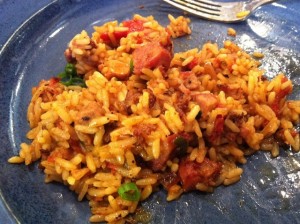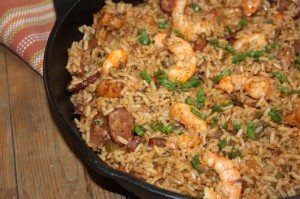
Chef John Besh and Andrew Evans at Besh's home (photo by Heather Wyatt, National Geographic Traveler)
Back in October, while scrolling through my “Who to Follow” list on Twitter, I came across this fella by the name of Andrew Evans who was tweeting all these wonderful and interesting things about New Orleans. After a couple of clicks here and there, I found out that Andrew is National Geographic Traveler magazine’s Digital Nomad who was in the Crescent City as part of a month-long exploration of South Louisiana. Throughout his trip, Evans tweeted, blogged and vlogged his travels on his Twitter account @WheresAndrew, his NationalGeographic.com’s Digital Nomad blog and his Facebook page. I was able to follow him, in real time, as he journeyed deep into our unique culture. If you missed it, you can retrace his steps on National Geographic’s website. During his excellent adventure, Andrew caught up with local celebrity and New Orleans native Chef John Besh at Besh’s home. There Andrew learned how to make what he proclaimed to be the “ world’s best jambalaya.” I’m happy Andrew was able to experience first hand the joys of living and eating like a New Orleanian. I mean what a cool job, huh? As for the rest of you, don’t despair. A heaping pot of jambalaya will quickly transport you there. But before you get cooking, here are a few interesting facts about the world famous and very versatile jambalaya.

Chef John Besh's Jambalaya (photo by Andrew Evans, National Geographic Traveler)
Jambalaya, like all the accomplished chefs and home cooks that prepare it, has multiple personalities. At a minimum, there’s red jambalaya and brown jambalaya. Red jambalaya has Creole roots, includes tomatoes in various forms and usually contains shrimp along with ham, chicken and/or sausage. Brown jambalaya hails from Cajun country, has no tomatoes, is usually full of andouille and/or tasso and does not contain seafood. Then there are jambalayas that blur the lines with various combinations of all those ingredients and more–think wild game and duck. Vegetarians have their own renditions as well. There are also different ways to prepare this favorite standby. Some cooks dump everything into a pot and hit go. While others add ingredients one at a time allowing their flavors to develop slowly and steadily. Most jambalayas are prepared in a large pot on the stove or outside over a propane flame. Others are started on the stove and finished in the oven. Several recipes even call for baking the dish in its entirety. But regardless of the ingredient list or instructions, jambalaya always reflects the passion and personality of the person preparing it and the final dish is always greater than the sum of its parts. That’s what makes each recipe worthy of that “world’s best” accolade.

Genêt's Jambalaya
If you’re looking to fully appreciate all that jambalaya is and develop your own distinct style, start by trying different recipes. Mine, for instance, is one of those “blurry” characters chock full of andouille, tasso, chicken and shrimp (and a long list of other ingredients that come together quickly and easily). I develop layers of flavor by browning the meats, caramelizing the Holy Trinity and drenching everything in beef consommé and French onion soup. A different approach would be Chef John Besh’s Pork & Sausage Jambalaya, which can be found on Andrew’s link above as well as in Besh’s new cookbook My Family Table: A Passionate Plea for Home Cooking. That version (Besh has different ones in each of his two cookbooks) calls for pork shoulder, pork sausage, tomatoes and chicken broth. They’re both deliciously homey and either one would make a great addition to your next holiday gathering, football party or supper menu. Enjoy!
Andouille, Tasso, Chicken & Shrimp Jambalaya Recipe
Seasoning Mix
2 whole bay leaves
1 tablespoon parsley flakes
1 teaspoon dried oregano leaves
1 teaspoon dried thyme leaves
1 teaspoon salt
1/2 teaspoon black pepper
1/4 teaspoon cayenne pepper
1/4 teaspoon white pepper
2 tablespoons bacon fat or canola oil
1/2 pound andouille smoked sausage, thinly sliced
1/2 pound tasso, diced
1/2 pound boneless, skinless chicken breasts, cut into bite-size pieces
1/2 pound boneless, skinless chicken thighs, cut into bite-size pieces
2 tablespoons tomato paste
1 cup chopped onions
1/2 cup chopped green bell peppers
1/2 cup chopped celery
2 garlic cloves, minced
1 jalapeno pepper, seeded and minced (optional)
1 10 1/2-ounce can beef consommé
1 10 1/2-ounce can French onion soup
1 10-ounce can original Rotel tomatoes, with liquid
1 cup beef broth
1/4 cup Lea & Perrins (Worcestershire sauce)
2 1/2 cups uncooked rice
1 stick butter, sliced
1 pound raw small (41 count or higher) or medium (26-40 count) shrimp, peeled (and deveined if you prefer)
1/2 cup chopped green onions
In a small bowl, thoroughly combine seasoning mix; set aside. Preheat oven to 350 degrees. In a large roasting pan or Dutch oven, heat bacon fat or oil over medium-high heat. If using a roasting pan, place it on the stove over two burners. Add andouille and tasso. Cook, stirring frequently, until meat starts to brown. Add chicken and continue cooking until chicken is brown, stirring frequently. Add tomato paste; cook, stirring constantly, until tomato paste browns. Stir in onions, bell peppers, celery, garlic and jalapenos. Cook, stirring frequently, until vegetables are tender and start to stick to the bottom of the pan. Deglaze pan by pouring in the beef consommé and scraping the bottom as needed. Remove pan from heat; stir in French onion soup, Rotel tomatoes, beef broth, Lea & Perrins and uncooked rice. Dot top with pats of butter. Cover tightly with aluminum foil or a fitted lid and bake for 40 minutes. Remove from oven; stir in shrimp and green onions. Return to oven and bake, uncovered, until shrimp are cooked and liquid is absorbed, about 10 minutes. Do not allow shrimp to overcook. Let sit for 5 minutes before serving. Reheat any leftovers with a little extra beef broth or butter. Serves 8-10.
Genêt



